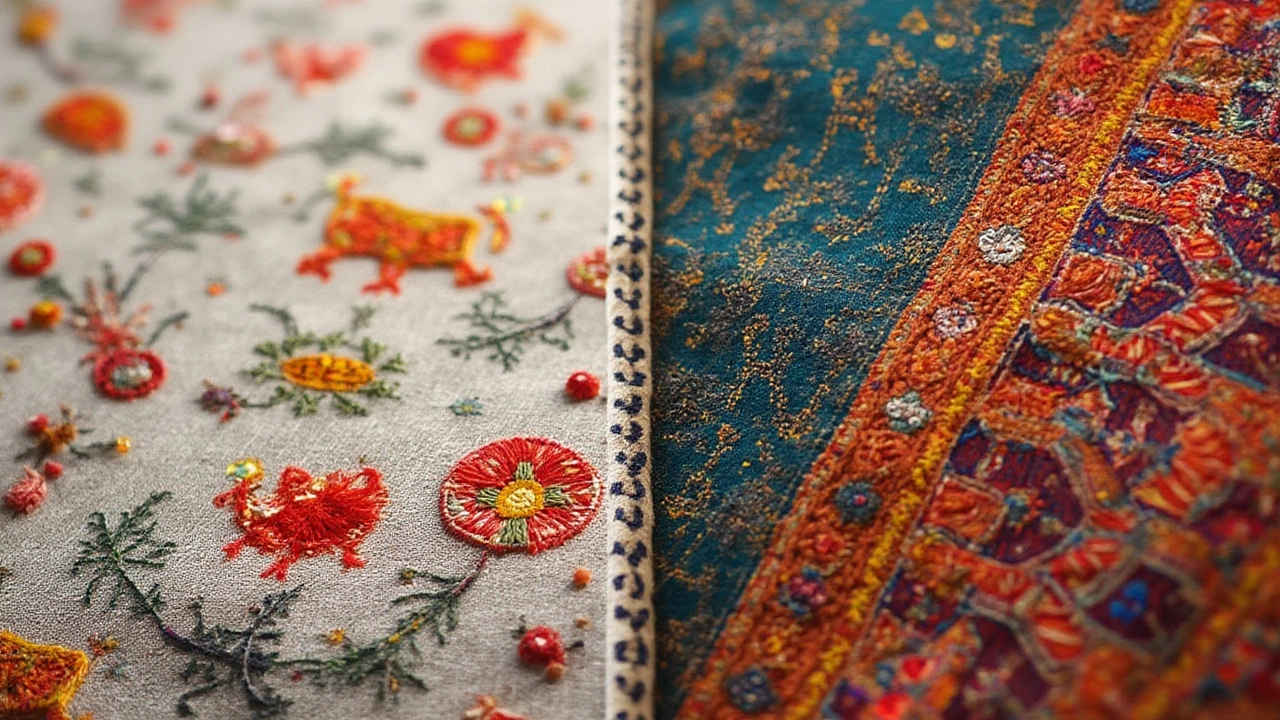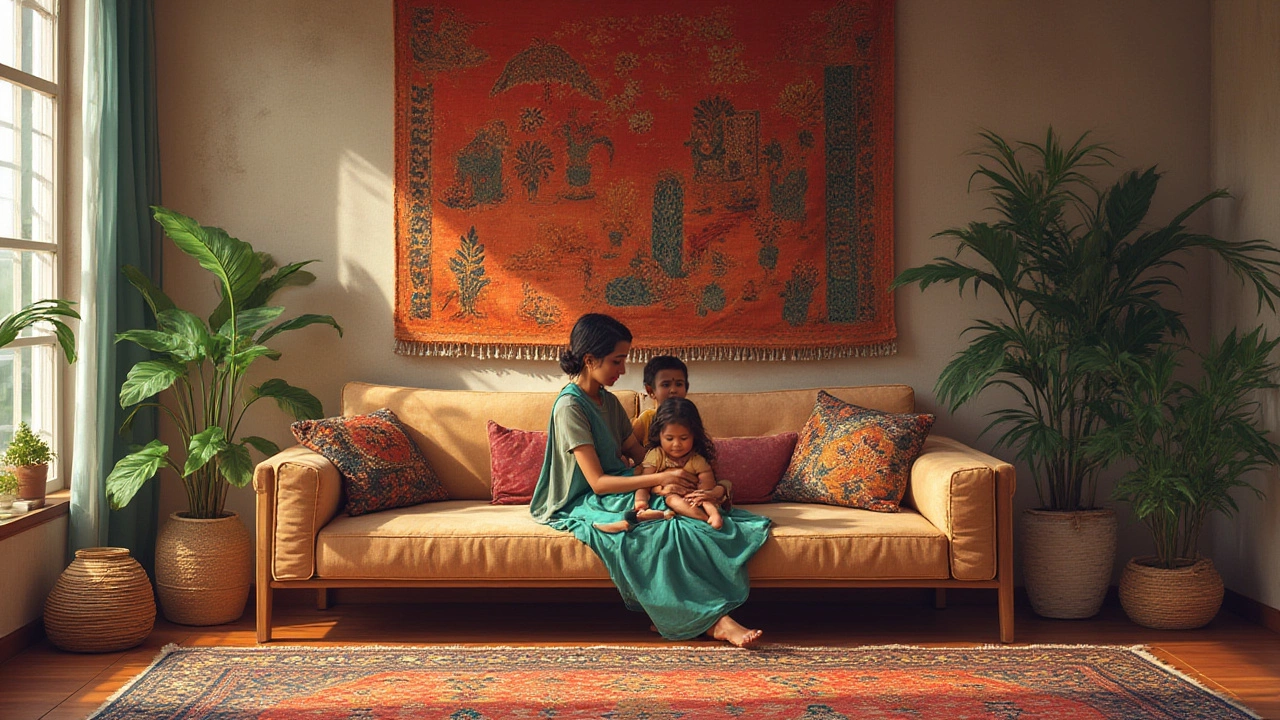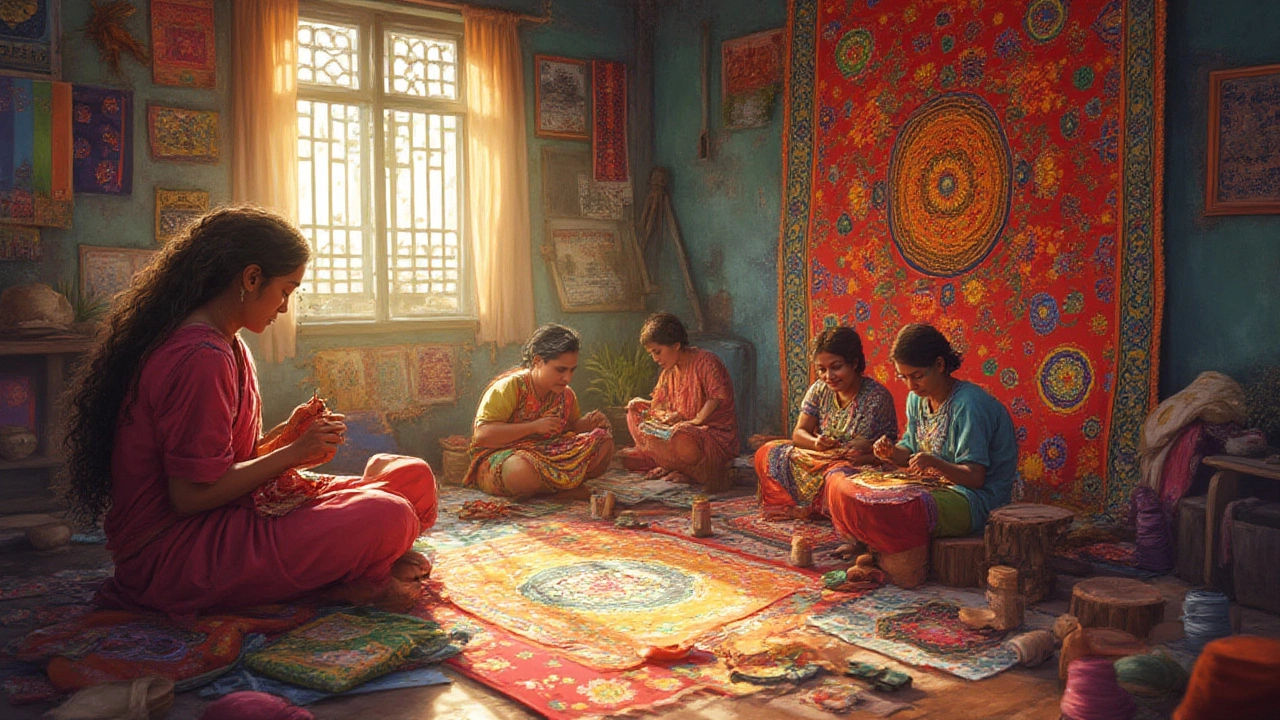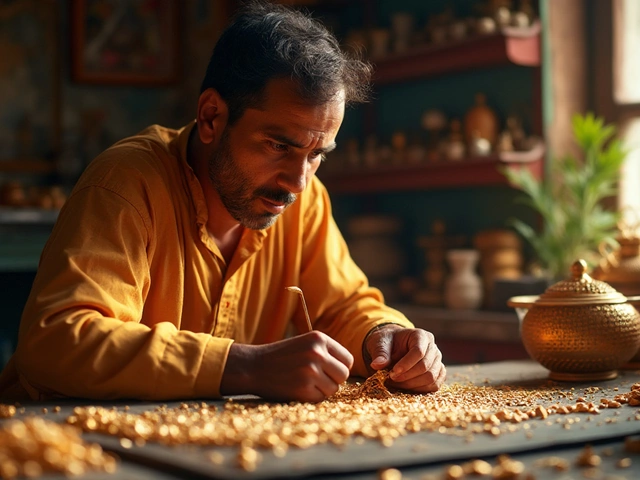There’s a quiet magic in a faded quilt stitched by hand, but would you believe two pieces could hide worlds apart in their threads? Sujni and kantha—two words tossed around at craft fairs and luxury home stores—aren’t just “Indian embroidery” sisters. They’re rivals in creativity, born hundreds of kilometers apart, shaped by the stories and hardships of entirely different women. Their difference isn’t about design alone. It’s about the lived realities of people who reinvented old fabric scraps into something beautiful, leaving us with clues stitched in cotton and dreams. Let’s unravel what makes sujni and kantha stand out from each other, and why mixing them up is more than just a rookie mistake.
Where Sujni and Kantha Began: Roots in Bihar and Bengal
If you pick up a kantha quilt at a Mumbai boutique or scroll through an online store, you’re probably seeing the end of a journey that began centuries ago in the damp, fertile regions of present-day West Bengal and Bangladesh. Kantha has been around since at least the 16th century, maybe even earlier—some records from Mughal times mention kantha as luxurious gifts. Women in rural Bengal stitched layers of dhotis and saris with a simple running stitch, improvising patterns from the world around them: fish, birds, the tree of life, paisleys, and geometric borders. It was their way of recycling, sure, but also of storytelling—wrapping loved ones in blessings, hopes, and fables.
Sujni, on the other hand, belongs to the dry alluvial plains of north Bihar. While its look-alike cousin, godhadi, pops up in Maharashtra with patchwork styles, sujni was mostly about embroidery, not layering. Historians say this tradition flourished in villages around Muzaffarpur and Madhubani from the early 18th and 19th centuries. In sujni, old dhotis or cotton saris formed the base. Women didn’t set out to display their craft; they made sujni quilts and ritual cloths (chadars) as keepsakes for weddings or the birth of a child, often depicting folk tales or goddess motifs in bold colors. While kantha literally means "rags" in Sanskrit, sujni comes from "su" (easy) and "jni" (to stitch), indicating something lovingly made at home.
What’s fascinating is how both traditions grew out of thrift but became art forms in their own right. A study published in 2016 by the Indian Journal of Traditional Knowledge puts the number of kantha makers in West Bengal alone at over 250,000, while the sujni craft cluster in Bihar employs a few thousand artisans. Their survival tells us how powerful small gestures of creativity can become, even if started as acts of necessity.
The Technique: Stitches That Tell Two Stories
The first real difference between sujni and kantha lies in their stitchwork. Kantha is famous for its running stitch—tiny, rhythmic dashes running across the surface, almost like lines in a diary. The designs begin with bold outlines, but it’s the rows of even stitches filling the shapes that create the characteristic puckered, rippled texture. The work is time-consuming—an average kantha quilt can take two to six months to finish, and the best antique pieces fetch lakhs at auction due to their detail and patina. Kantha motifs often flow in a spiral, with borders defined by complex stitch patterns.
Sujni, though, relies more on chain stitch and sometimes a herringbone (bakhia) stitch for outlining. The filling is mostly done with simple running stitches, but the effect is different: instead of puckering, sujni’s surface appears smoother and flatter, letting the bold colored patterns stand out sharply against the background. There’s also no fixed rule about the base cloth’s layers—most sujnis are thinner than kanthas, and less about warmth. The chain stitch, worked in red, yellow, or black thread—often directly outlines gods, animals, trees, and sometimes entire village scenes.
If you ever get confused, flip the piece over: kantha quilts tend to show their rows of running stitch front and back, creating a slightly uneven texture throughout. Sujni’s reverse usually looks plain, with the main action all on the top. Museums cataloguing these textiles have even used this test to separate old eastern Indian quilts—though it’s getting harder to do as contemporary designers start mixing styles.

Stories, Motifs, and Meaning: What Each Piece Tries to Say
You can’t talk about either tradition without mentioning their storytelling. Kantha’s heart is in the folk tales and daily scenes women imagined—rowboats gliding through water, elephants marching through the brush, mothers cradling babies, even popular characters from the Ramayana or local legends. There’s a spontaneous, free-spirited look to kantha. In the 19th century, writer Nihar Ranjan Ray even described how rural women "poured out their innermost thoughts in kantha, giving shape to happiness, sorrow, hardship, and desire." He wasn’t exaggerating. Many surviving antique kanthas read like illustrated journals, pieces of cloth where dreams and ideas got a permanent home, tucked under linen folds. Colors tended to be subtle, coming from natural dyes—think faded indigos, soft reds, leaf greens—because the source fabric was always reused saris or dhotis.
Sujni, meanwhile, followed a more ceremonial path. Most classic sujnis were gifts at rites of passage: weddings, childbirth, or as an offering in the family prayer room. Here, the motifs tend to be more formal and repeated, often built around central themes. You’ll see goddess figures—a favorite is Durga defeating Mahishasura, or depictions of Krishna and Radha—along with elephants, crocodiles, birds in stylized symmetry. Floral borders, the sun and moon, geometric mandalas: these recur in almost every piece. Unlike the quiet tales of kantha, sujni was meant to invite good luck, fertility, and spiritual blessings. The color palette is bolder with lots of red, black, blue, and gold—sujni work even adds tiny mirrors (shisha) sometimes for protection or to reflect evil eyes away. The result feels grand, almost regal, compared to breezy, everyday kantha.
Want to spot a quick difference? Most old kanthas write stories in narrow horizontal bands, or all-over semi-abstract patterns with no central centerpiece, but many sujni works are organized in panels or around a main motif, like a painted scroll. If you find a piece with writing stitched onto it, it’s more likely to be kantha—a personal dedication or blessing—whereas sujni sticks to images over text.
Modern-Day Revival: From Village Craft to Designer Collections
In the last two decades, the sleepy world of kantha and sujni has seen a sharp revival, fueled by everything from international exhibitions to Instagram pop-up shops. The market for handcrafted textiles is booming: the Indian handicraft industry exported nearly $4 billion of textiles in 2023 alone, with a healthy chunk credited to embroidery-rich products like kantha quilts, cushion covers, and jackets. Designers such as Sabyasachi Mukherjee and Ritu Kumar have put vintage kantha in their bridal couture lines, while sujni motifs are popping up in contemporary homeware—bedspreads, table runners, notebook covers, even wall hangings.
Bihar’s sujni tradition was considered nearly extinct by the 1990s, until NGOs like Mahila Vikas Sahyog Samiti trained new generations and set up cooperatives. Makers now earn steady incomes by crafting modern versions—patchwork shawls, cushion covers, and tote bags that blend traditional motifs with muted color schemes loved by city dwellers. Many craftswomen even sign their pieces, a far cry from bygone days when their work was anonymous. For kantha, collectives like Rangasutra and Sasha Exports have helped rural Bengali women break the poverty cycle, turning their inherited art into a badge of pride.
| Region | Main Stitch | Motifs | Main Use | Average Time to Make (quilt) |
|---|---|---|---|---|
| Bihar (Sujni) | Chain, running, herringbone | Goddess, animals, rituals | Ritual, ceremonial | 2-3 months |
| Bengal (Kantha) | Running | Nature, stories, daily life | Utility, gifting | 2-6 months |
If you’re keen to buy a piece, here’s a quick tip: spot the texture. Kantha items tend to be slightly rough and puckered thanks to that all-over running stitch, while sujni feels smoother, sometimes even stiff when new. Check for scenes—kantha will show daily life, sujni more religious themes. Real vintage quilts have visible patching and color fading; most modern ones mimic these effects, so don’t be shy to ask about origin and history, especially if paying a premium.

How to Care, Collect, and Identify: Tips for Textile Lovers
Few things beat the feeling of wrapping up in a real handmade kantha or displaying a sujni on your wall. But these are delicate works—one wrong wash, and decades of work could unravel (pun intended). Start by always handwashing in cold water with a gentle detergent, and never wring out the pieces. Dry them flat out of direct sunlight to avoid fading. If you plan to use your kantha or sujni daily—as a bedspread or tablecloth—rotate its use and let it breathe, as cotton fibers can weaken if packed away wet or left in humid corners.
Collectors and designers love hunting down rare motifs—kantha showing British colonial scenes, or sujni with unusual border patterns can fetch record prices. Also, if authenticity matters, look for layers: kantha will have three to seven layers of old cloth, often visible at worn spots. Sujni, being thinner, wears out quicker but retains its color and embroidery definition longer. Museums in Kolkata and Patna have entire galleries of these textiles if you want a masterclass in spotting the real deal. Remember, new pieces shouldn’t smell overwhelmingly of chemicals—that’s usually a red flag for machine-made knockoffs meant for export markets.
Here’s another fun fact: UNESCO gave both Bengal kantha and Bihar sujni special recognition under its Intangible Cultural Heritage list, and local craft clusters arrange tours for those interested in seeing the process first-hand. Watching artisans at work, you’ll notice there’s no trace of stencils or printed patterns—they work freehand, by memory and intuition, which explains why no two authentic pieces ever look identical. Don’t expect perfection in every stitch; the little quirks are the signature of a real handmade piece.
If you’re thinking of gifting a piece, choose kantha for a housewarming (great as a cozy quilt or a bohemian throw) and sujni for weddings or pujas (its lucky motifs make it special). Always ask the seller if they can tell you more about the maker. Many honest shops in India now tie up directly with women’s groups—your purchase does more than just add beauty to your home; it supports a centuries-old skill that could easily have been lost to modern automation.
So the next time you see the terms sujni and kantha mixed up, you’ll know which stories, stitches, and spirits are hiding in each, waiting to be discovered—one seam at a time.



